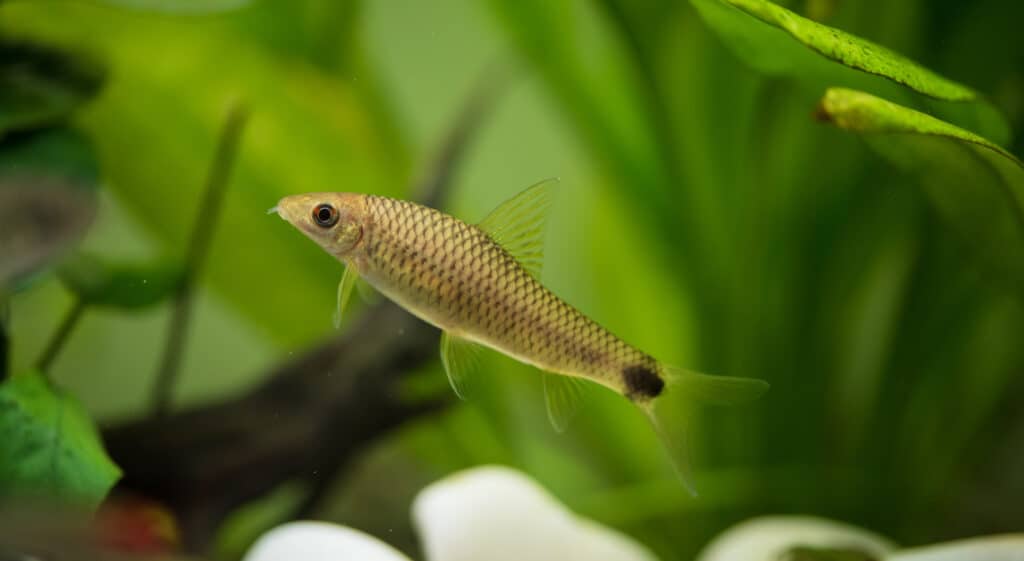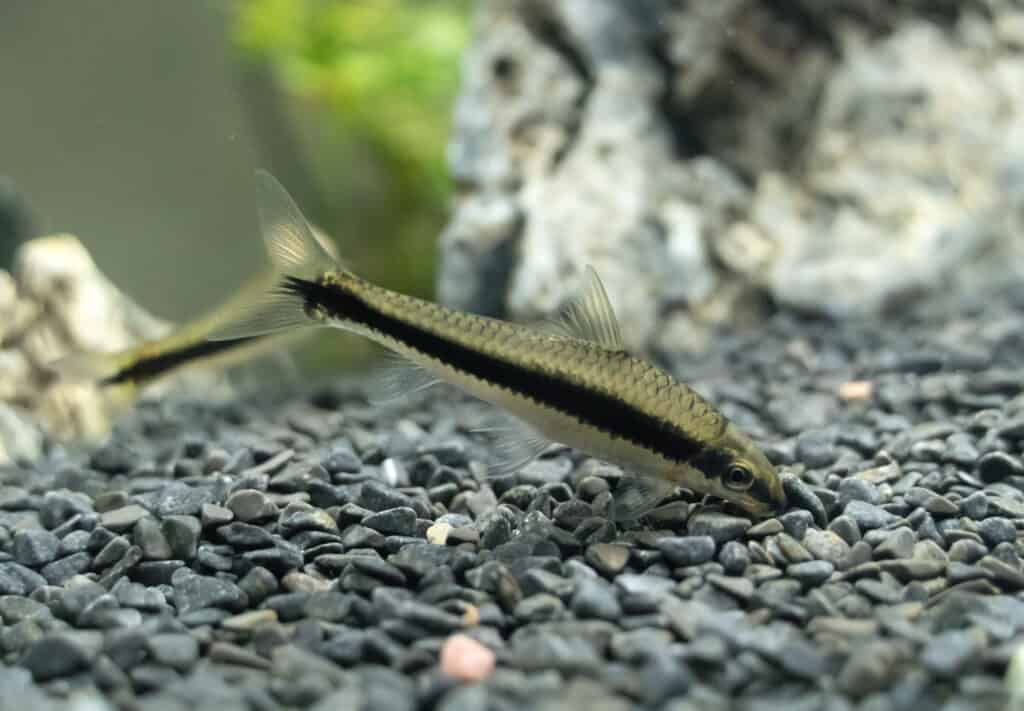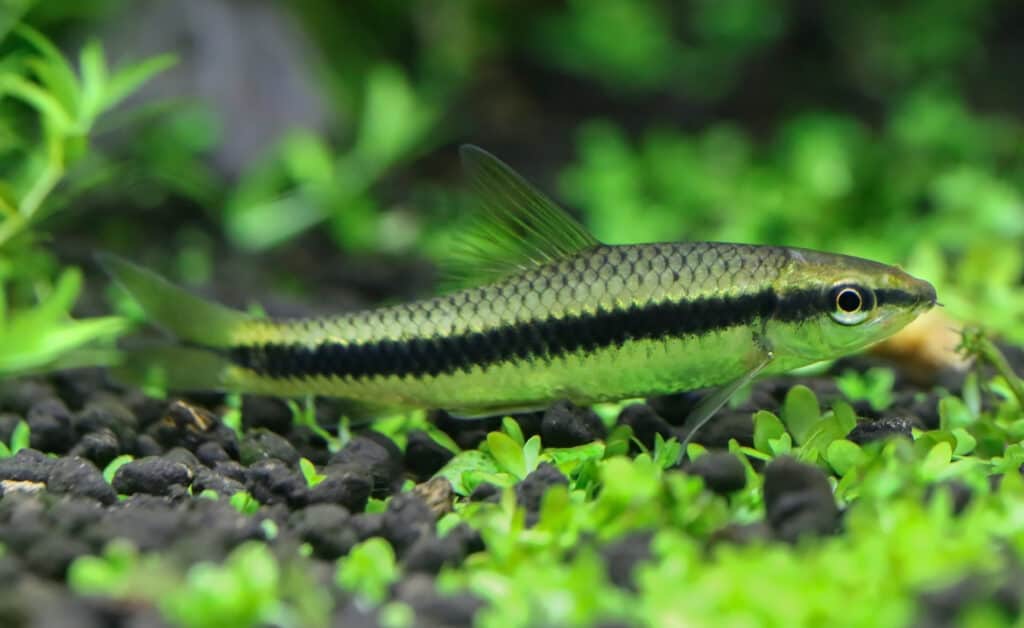The flying fox and Siamese algae eater are both fish that are extremely popular in the aquarium trade. They are kept in tanks around the world and make for great cleaners. Although these fish are extremely similar and come from the same place in the world, they are actually different species. Today, we will look at these two fish and learn a bit about what makes them special. Let’s compare: Flying Fox Fish vs Siamese Algae Eater!
Comparing the flying fox fish and the Siamese algae eater

The flying fox eats mostly algae, but it will also eat vegetation and food flakes.
©Przemek Iciak/Shutterstock.com
| Flying fox fish | Siamese algae eater | |
|---|---|---|
| Color | More yellow in color with a smooth black stripe. Black tinted fins. | More green in color with a more jagged black stripe. Clear fins. |
| Length and shape | 6 inches full grown. Thinner and flatter than the Siamese algae eater. | 6 inches full grown. Tapered body that is thickest in the middle near the dorsal fin. |
| Mouth shape | Fleshy flap in the corner of the mouth. More prominent barbels. | No fleshy flaps. Little to no barbels present. |
| Algae preferences | Prefers green algae but will eat flakes, tablets, and other things. Will not eat red algae. | The only fish species known to eat red algae. |
The 4 main differences between a flying fox fish and a Siamese algae eater

The flying fox has a smooth black stripe and a thin gold stripe directly above it.
©Przemek Iciak/Shutterstock.com
The main differences between the flying fox and the siamese algae eater are color, length and shape, mouth shape, and algae preferences.
The flying fox and Siamese algae eater are two small fish native to freshwater environments in Southeast Asia. These schooling fish are rather ubiquitous in the aquarium trade and are found in pet stores all over the world. Their similarities in appearance often lead to them being confused for one another, although they’re entirely different species.
Both species grow to around 6 inches long, although they are susceptible to aquarium stunting. The colorations between the two are similar, but there are a few key differences. The flying fox has a smooth black stripe and a thin gold stripe directly above it, and the algae eater has a more jagged black stripe and no thin stripe over it. Additionally, the flying fox has tinted fins while the algae eaters are clear.
Outside of appearances, one of the most important differences between the two fish is their dietary preferences. The flying fox eats mainly algae, but it will also eat vegetation and food flakes. The Siamese algae eater, as its name suggests, primarily eats algae. What makes the difference unique is that the SIamese algae eater also gets red algae and is the only fish in the world known to do so. As such, it is highly prized in home aquariums.
Let’s explore these differences a bit more below.
Flying Fox Fish vs Siamese Algae Eater: Color

The Siamese algae eater is more green in color than the more yellow/gold flying fox.
©M-Production/Shutterstock.com
The best way to distinguish between the two fish is their colors and patterns. Flying fox fish have a smooth black stripe running down their sides, with a thin gold stripe directly above the black one. The smoothness of the black line is an important detail that differentiates it from the algae eater. Additionally, the flying fox has tinted find, usually brown or black.
The Siamese algae eater is more green in color than the more yellow/gold flying fox. The black stripe runs the same way as the flying fox; only it has a jagged edge caused by the scales. Additionally, there is no extra stripe, and its fins are clear.
Flying Fox Fish vs Siamese Algae Eater: Length and shape

The flying fox is thinner and has a consistent thickness until the base of its tail.
©Przemek Iciak/Shutterstock.com
When it comes to length, both fish are quite similar. They can grow to around 6 inches at a maximum, although the aquarium’s size impacts length. The flying fox is thinner and has a consistent thickness until the base of its tail.
The Siamese algae eater grows to the same length as the flying fox but is a bit wider. It’s tapered from head to tail, with the thickest portion near the center of the fish’s body near the dorsal fin.
Flying Fox Fish vs Siamese Algae Eater: Mouth shape

The Siamese algae eater has no mouth flap or barbels.
©Swapan Photography/Shutterstock.com
Flying foxes have a small mouth flap occasionally visible from the side or front. Additionally, they have distinct barbels on either side of their mouths.
The Siamese algae eater doesn’t have a mouth flap and has very small barbels or none.
Flying Fox Fish vs Siamese Algae Eater: Algae preferences

The Siamese algae eater is the only fish known to eat red algae.
©Grigorev Mikhail/Shutterstock.com
The flying fox is an algae eater that primarily feeds on green algae in the wild. In captivity, they also eat fish flakes and some vegetation.
The Siamese algae eater is an algae eater famously known to eat red algae. In fact, they are the only known species of fish that eats red algae, making them essential for their ecosystems and valuable in the aquarium trade.
The photo featured at the top of this post is ©
Thank you for reading! Have some feedback for us? Contact the AZ Animals editorial team.







